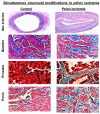Molecular Regulation of Concomitant Lower Urinary Tract Symptoms and Erectile Dysfunction in Pelvic Ischemia
- PMID: 36555629
- PMCID: PMC9782153
- DOI: 10.3390/ijms232415988
Molecular Regulation of Concomitant Lower Urinary Tract Symptoms and Erectile Dysfunction in Pelvic Ischemia
Abstract
Aging correlates with greater incidence of lower urinary tract symptoms (LUTS) and erectile dysfunction (ED) in the male population where the pathophysiological link remains elusive. The incidence of LUTS and ED correlates with the prevalence of vascular risk factors, implying potential role of arterial disorders in concomitant development of the two conditions. Human studies have revealed lower bladder and prostate blood flow in patients with LUTS suggesting that the severity of LUTS and ED correlates with the severity of vascular disorders. A close link between increased prostatic vascular resistance and greater incidence of LUTS and ED has been documented. Experimental models of atherosclerosis-induced chronic pelvic ischemia (CPI) showed increased contractile reactivity of prostatic and bladder tissues, impairment of penile erectile tissue relaxation, and simultaneous development of detrusor overactivity and ED. In the bladder, short-term ischemia caused overactive contractions while prolonged ischemia provoked degenerative responses and led to underactivity. CPI compromised structural integrity of the bladder, prostatic, and penile erectile tissues. Downstream molecular mechanisms appear to involve cellular stress and survival signaling, receptor modifications, upregulation of cytokines, and impairment of the nitric oxide pathway in cavernosal tissue. These observations may suggest pelvic ischemia as an important contributing factor in LUTS-associated ED. The aim of this narrative review is to discuss the current evidence on CPI as a possible etiologic mechanism underlying LUTS-associated ED.
Keywords: atherosclerosis; bladder; erectile dysfunction; ischemia; lower urinary tract symptoms; oxidative stress; prostate.
Conflict of interest statement
The authors declare no conflict of interest.
Figures




Similar articles
-
A new experimental rat model of erectile dysfunction and lower urinary tract symptoms associated with benign prostatic hyperplasia: the testosterone-supplemented spontaneously hypertensive rat.BJU Int. 2012 Nov;110(9):1352-8. doi: 10.1111/j.1464-410X.2012.11085.x. Epub 2012 Mar 27. BJU Int. 2012. PMID: 22448674
-
Interrelation of erectile dysfunction and lower urinary tract symptoms.Drugs Today (Barc). 2005 Aug;41(8):527-36. doi: 10.1358/dot.2005.41.8.893711. Drugs Today (Barc). 2005. PMID: 16234876
-
Critical analysis of the relationship between sexual dysfunctions and lower urinary tract symptoms due to benign prostatic hyperplasia.Eur Urol. 2011 Oct;60(4):809-25. doi: 10.1016/j.eururo.2011.06.037. Epub 2011 Jun 29. Eur Urol. 2011. PMID: 21726934 Review.
-
[Relationship between lower urinary tract symptoms in men and erectile dysfunction].Semergen. 2016 Apr;42(3):164-71. doi: 10.1016/j.semerg.2015.07.005. Epub 2015 Dec 10. Semergen. 2016. PMID: 26452608 Review. Spanish.
-
Erectile Dysfunction and Lower Urinary Tract Symptoms.Eur Urol Focus. 2017 Oct;3(4-5):352-363. doi: 10.1016/j.euf.2017.11.004. Epub 2017 Nov 27. Eur Urol Focus. 2017. PMID: 29191671 Review.
Cited by
-
A New Rat Model of Sacral Cord Injury Producing a Neurogenic Bladder and Its Functional and Mechanistic Studies.Biomolecules. 2024 Sep 9;14(9):1141. doi: 10.3390/biom14091141. Biomolecules. 2024. PMID: 39334907 Free PMC article.
-
Evaluation of community pharmacy technicians' knowledge, attitudes, and practices about erectile dysfunction and its predictors in Gondar Town: A cross-sectional descriptive study.Heliyon. 2024 Aug 17;10(16):e36317. doi: 10.1016/j.heliyon.2024.e36317. eCollection 2024 Aug 30. Heliyon. 2024. PMID: 39253239 Free PMC article.
-
Insights into the associative role of hypertension and angiotensin II receptor in lower urinary tract dysfunction.Hypertens Res. 2024 Apr;47(4):987-997. doi: 10.1038/s41440-024-01597-8. Epub 2024 Feb 14. Hypertens Res. 2024. PMID: 38351189 Review.
References
Publication types
MeSH terms
LinkOut - more resources
Full Text Sources
Medical

